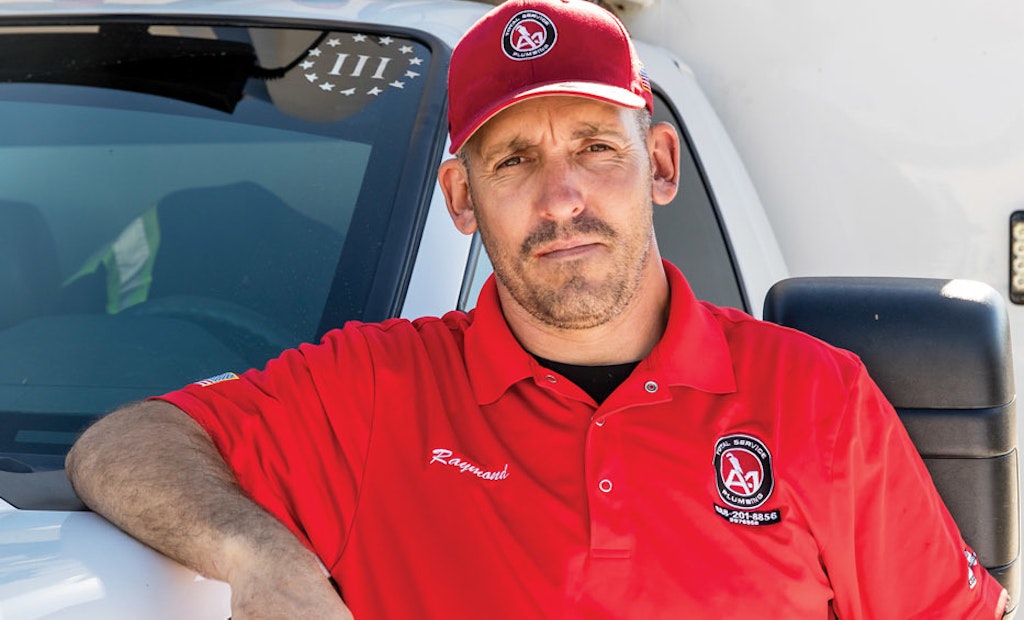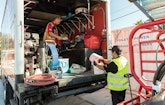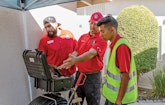
A-1 Total Service Plumbing owner Raymond Gray branched out to start his own firm in 2003, and now has 42 employees.
Interested in Relining/Rehab?
Get Relining/Rehab articles, news and videos right in your inbox! Sign up now.
Relining/Rehab + Get AlertsAdopting a stakeholder model for his two businesses, A-1 Total Service Plumbing and A-1 Total Service Construction, has enabled Raymond Gray to create a thriving workplace for his employees.
Gray prioritizes providing opportunities for growth and a chance to be part of executing effective, long-term solutions for both his commercial and residential client base. Developing needed resources from the ground up and never shying away from a challenge, the two firms have gained a reputation for excellence, quality service and optimum return on investment for the customer. Because of this, A-1 is being tapped to be involved in some of Southern California’s high-profile and unique projects.
In his genes
Gray comes from a long line of master plumbers and pipeline master craftsmen: His great-grandfather and grandfather were both steamship pipe fitters, and his father is a master plumber and an active leader and trainer for the plumbing side of A-1.
Gray began his career with another service firm, working alongside his now general manager, Thomas Allen. He was learning a lot but grew frustrated with what he perceived as poor business practices by his employer, such as overcharging or forcing staff to cut corners and not properly complete a project in order to squeeze as many calls as possible into a single workday. The long days and feeling like he could have provided more to his customers took their toll. So he decided to make a change in 2003 and start his own firm, operating by his own rules and values.
“I wanted to change how I was perceived by customers. I wanted to provide better service, to be known for delivering exceptional value,” Gray says. Fast-forward to 2018 when he began to experience the growing pains of all successful businesses and he knew it was time to bring in a general manager to help with the running of the businesses. He reached out to Allen. Their management styles were very different, which would bring advantages and some new energy and balance to the organization. But, more important, the two shared a common vision of how a plumbing and service contractor firm should be run.
“Just like Ray, I wanted to deliver that five-star, red-carpet service. It’s not about the dollar; it’s about providing service. Because we want to be our customers’ plumber forever, not just for this one project,” Allen says. “When you deliver that experience, customers are going to call you back every time and they’re going to tell their neighbors — and that’s priceless.”
Gearing up
The number of employees for the two firms fluctuates, but Gray currently employs 42 people, many of whom do work for both branches. At present, they are recruiting but have learned they can’t simply hire any plumber. Because of the increased demand for their trenchless technology services and more complex plumbing projects, it is critical for those crew members to have a certain mindset. Many applicants with years of plumbing experience are not always a good fit, especially if they have been jumping from job to job in search of financial gain.
“When a staff member is focused purely on revenue, we experience multiple recalls and failures on jobs. This eats into the company’s bottom line, removing the profit from the original job with do-overs on something that should have been easily completed correctly if it’s not rushed through — and not to mention risking a good client relationship,” Gray says.
Knowing this, Gray and Allen have taken a different approach to recruiting: Hire on character, not on experience. “I would rather take a person with great character and work ethic who doesn’t know anything and teach him the skills needed, the old-school way — that hard work pays off,” Allen says. “We are willing to invest in them if they are willing to invest in themselves and a career in this industry and just go out there and get their hands dirty with us.”
A-1 also isn’t shy about investing in the right tools to perform and expand their service capabilities. Gray was an early adopter of CIPP, acquiring his first Perma-Liner Industries relining rig 15 years ago and has consistently added to his lineup, purchasing just about everything the company offers. He also invested in IMS Robotics GmbH lateral reinstatement cutters, a Dancutter robotic cutter and spray lining system, as well as a TRIC Tools 30-ton pipe bursting machine with a 100-ton unit on order to be deployed on an upcoming job.
In addition to the full trenchless technology rehabilitation arsenal, A-1 has a Pearpoint (USA) P354 portable mainline camera inspection system with large and small crawlers; Aries mainline camera vehicle-mounted system; Cam Spray van-mounted jetter; a selection of Workhorse nozzles that include an Aquadrill, Spider 60 and Radial; StoneAge Warthog WS-1/2 and WT-3/8 nozzles; RIDGID SeeSnake push cameras; and Radiodetection locators.
All this equipment and its field experience enable A-1 to aid in the development and testing of new trenchless repair equipment and to perform lateral launches, T-liner installations, vertical stack repairs and much more.
High-profile jobs
Because of the diverse range of equipment and skills they provide, A-1 has become a go-to resource for some of the region’s prime contractors who are dealing with high-profile or difficult trenchless projects. Case in point, the lining job for a 500-foot-long line with an access point from a 30-feet-deep manhole in a terminal at the Los Angeles International Airport. The project involved moving a jumbo jet to access the deep entry manhole and run the liner, manhole to manhole, from a starting point on the tarmac into the end point situated in the departure area where passengers are dropped off. The depth and location of the line, as well as traffic control and logistics of installation, made the project extremely challenging, yet for Gray and Allen, it was just “another day at the office.”
It made the rehabilitation of the sewer mains for Leisure World Seal Beach seem easy in comparison. A-1 is using CIPP to renew the lines for 70 of the retirement community’s buildings. Leisure World is treated as a “city within a city,” responsible for its own infrastructure maintenance. So although it has the characteristics of a public sewer system project, A-1 has the advantage of being contracted with a private entity. The owners have been so pleased with the quality results and crews working in the community that they are writing new contracts for some of the 400 other buildings in the complex, which Gray and Allen anticipate will keep them busy for the next decade.
When new and challenging opportunities present themselves, Gray doesn’t hesitate to invest in the tools needed, like the new 100-ton TRIC Tools pipe bursting unit that will soon be utilized to rehabilitate a 6-inch water main in Orange County. The original project rehabilitation design called for descaling and cleaning of the main, to be followed by an epoxy lining for renewal and life extension. Because of its location and age, Gray was concerned about the structural integrity of the line and that after cleaning and epoxy-lining, some sections would not be thick enough or sufficiently sound to have the necessary flanges welded back onto it. As a backup plan, A-1 will have the TRIC Tools 100-ton bursting machine at the ready for the crews to split and cut out any unstable sections of the ductile steel and pull polyethylene in its place to restore full integrity to the entire line.
Building relationships
A-1 has been tapped for many interesting projects, yet doesn’t rely on marketing efforts to get the work. Gray says most of those jobs are word-of-mouth referrals from colleagues in the industry who know he does good work. “I could do most of this work myself, but I have friends in the industry and people who are referred to me. It would be my downfall not to do joint venture projects with them.”
A prime example is John West of Ultra Engineering in San Diego, who called John Pujol of Advanced Infrastructure Technologies in Torrance and asked for a referral. Pujol rarely provides endorsements, but since he had been supplying A-1 with most of its equipment for years and knew how Gray and Allen conducted business, he didn’t hesitate to connect the firms. This resulted in A-1 performing some challenging CCTV inspections in some large-diameter storm drainlines in a strip mall. Construction had just been completed and inspection was required for the building inspector’s final signoff. Debris had fallen into the lines, making inspection difficult; but the A-1 crews were able to complete the required inspection.
West was so pleased with the outcome that he continued the “pay it forward” energy by referring Gray to other contractors, which led to more projects, more happy customers and more referrals. West’s company and A-1 continue to collaborate on some of area’s most unusual and challenging projects. Through its networking and referrals, A-1 now boasts an impressive client project roster that includes Century City, U.S. naval bases from San Pedro to South Orange County, large malls, medical centers and hotels.
The right attitude
While most firms will look at failures as a negative, Gray and Allen have taken a different position, citing a big part of the companies’ successes on having experienced those failures. “I’ve posted some of the failures I’ve had on social media, something most people won’t do,” Gray says. “They only post about the successes. But us overcoming some of the failures we’ve had is what’s made us more successful because we’ve never given up. We learn and keep pushing forward.”
Allen adds that being fearless has contributed to their prosperity as well. “We like to teach our crews to not be afraid to take on a new challenge because the industry is evolving, and we have a chance to be part of that. We take the tough projects on because they challenge us, not scare us.” Because of their willingness to stretch, vendors like Perma-Liner invite them to offer tips, project method ideas, and insights on how to improve technology because they are bringing real-world field experience to the research-and-development teams — offering a perspective that office-bound engineers or managers don’t have the opportunity to access.
A-1 prides itself on its quality and commitment to the customer and go where they’re needed if the project and profits make sense. But not every project will make sense, and Gray has learned it is OK to say no. His standard is to deliver quality work for an appropriate price. “When customers ask why something costs what it does, I explain that the difference between our firms and others is that we don’t need their work — we’re always busy. But we want their work and to serve them and serve them properly. What we are charging is what’s needed to accomplish that.”
Seeing the potential
When presented with an unusual project opportunity, Raymond Gray, owner of A-1 Total Service Plumbing, looks beyond the obvious potential as he makes equipment purchases for his plumbing and trenchless rehabilitation business.
When offered a contract to perform demolition on several properties, Gray needed to carefully weigh his options. Demolition wasn’t a typical project for his firm, but it would offer the opportunity to learn and handle some new sewer and other buried utility excavation-related applications that his crews wouldn’t get a chance to be exposed to otherwise.
The next question was whether to rent or buy the needed equipment. After researching the cost of new equipment, used equipment and renting, he determined that purchasing used equipment (including an excavator and several skid-steers) would be just $25,000 more than renting the required machines for the expected 12-month duration of the project.
When it comes to new opportunities or things outside the normal scope of work or expertise and the equipment required, Gray advises looking beyond the immediate need. “I look at the potential future work, jobs and projects down the line that I could qualify for and be awarded because I have that particular equipment in my fleet. Then I do the math to see if it makes sense to buy new, buy used or rent. If I break even on the first job that required that purchase, it’s a win because even if we didn’t like the work and don’t want to pursue more of it, I have an option to sell it and regain some of the investment.
“But for us, we’ve never sold it. We always find ways to sell more jobs from new equipment acquired and enjoy letting it pay for itself over and over.”










